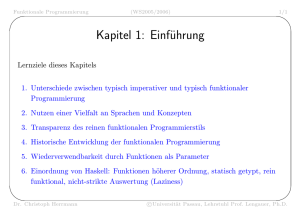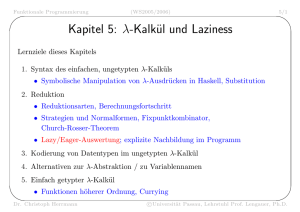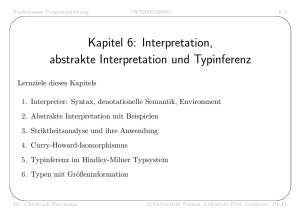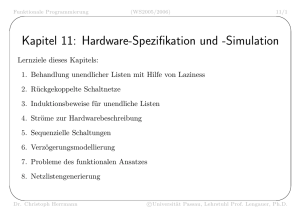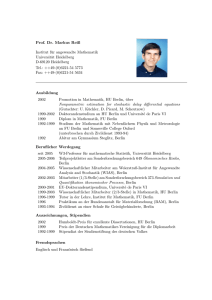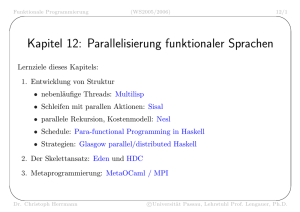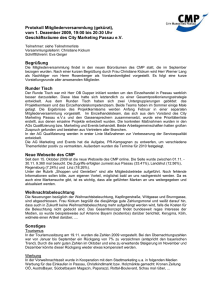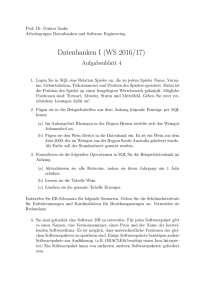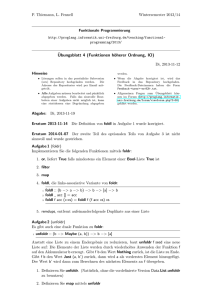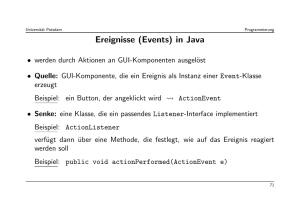Programmierung mit Kombinatoren - Infosun
Werbung
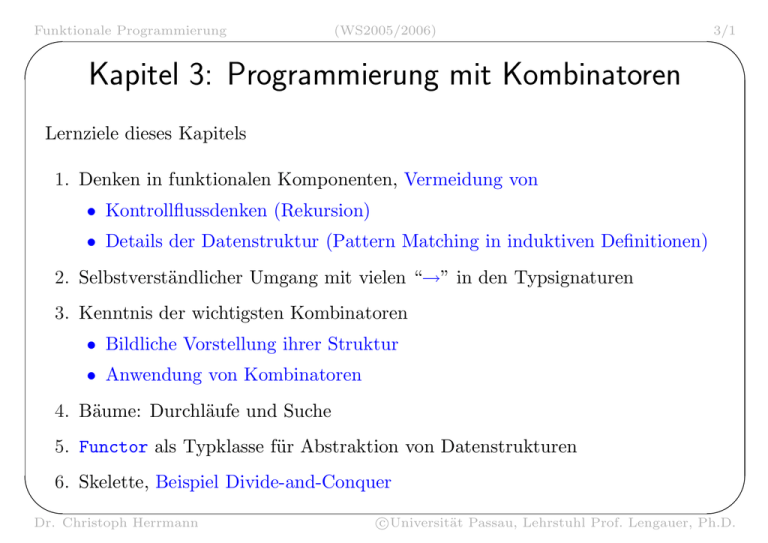
Funktionale Programmierung ' (WS2005/2006) 3/1 $ Kapitel 3: Programmierung mit Kombinatoren Lernziele dieses Kapitels 1. Denken in funktionalen Komponenten, Vermeidung von • Kontrollflussdenken (Rekursion) • Details der Datenstruktur (Pattern Matching in induktiven Definitionen) 2. Selbstverständlicher Umgang mit vielen “→” in den Typsignaturen 3. Kenntnis der wichtigsten Kombinatoren • Bildliche Vorstellung ihrer Struktur • Anwendung von Kombinatoren 4. Bäume: Durchläufe und Suche 5. Functor als Typklasse für Abstraktion von Datenstrukturen 6. Skelette, Beispiel Divide-and-Conquer & Dr. Christoph Herrmann c °Universität Passau, Lehrstuhl Prof. Lengauer, Ph.D. % Funktionale Programmierung ' (WS2005/2006) 3/2 $ Programmierung mit Kombinatoren • Kombinator: Funktion ohne freie Variablen • Bedeutung unabhängig von der Umgebung • klare Funktionalität • hohe Wiederverwendbarkeit • geeignet für spezielle effiziente Implementierung • Skelett: Kombinator mit umfangreicher Funktionalität & Dr. Christoph Herrmann c °Universität Passau, Lehrstuhl Prof. Lengauer, Ph.D. % Funktionale Programmierung ' (WS2005/2006) 3/3 $ Kombinatoren statt expliziter Rekursion Beispielaufgabe: revertieren einer Liste • schlechte Lösung mit expliziter Rekursion revertiere l = if null l then [] else let rest = revertiere (tail l) ansEnde l1 = if null l1 then [head l] else head l1 : ansEnde (tail l1) in ansEnde rest • gute Lösung mit Kombinatoren revertiere = foldl (flip (:)) [] & Dr. Christoph Herrmann c °Universität Passau, Lehrstuhl Prof. Lengauer, Ph.D. % Funktionale Programmierung ' (WS2005/2006) 3/4 $ Aspekt Programmierstil einige der wünschenswerten Eigenschaften . . . 1. Vermeidung impliziter Definitionen (Rekursion) 2. Vermeidung von Fallunterscheidungen (if-then-else) 3. Bezug auf Datenstrukturen so gering wie möglich halten 4. Wenn Datenstrukturen, dann Pattern Matching statt Selektoren 5. Funktionsgleichungen ohne Bezug auf Argumente (→ pointfree style) . . . und warum diese wünschenswert sind: • (1),(2),(4),(5): Vereinfachung von Beweisen und Programmtransformationen • (1),(2),(3),(4): Verkürzung des Quelltextumfangs ⇒ bessere Lesbarkeit • (3): Austauschbarkeit von Teilen der Implementierung & Dr. Christoph Herrmann c °Universität Passau, Lehrstuhl Prof. Lengauer, Ph.D. % Funktionale Programmierung ' (WS2005/2006) 3/5 $ Der Nutzen von Kombinatoren • Bereitstellung häufig vorkommender Programmschemata (map, foldl, . . . ) • Kapselung von Rekursion und Fallunterscheidungen • Anpassung von Repräsentationen (flip, concat, . . . ) • Skelette: Faktorisierung einer Problemlösung in – algorithmischen Anteil (Depth-First-Suche, Divide-and-Conquer, . . . ) – Anwendungs-spezifische Operationen • Einfache Regeln für Programmtransformationen z.B. map g . map f = map (g . f) & Dr. Christoph Herrmann c °Universität Passau, Lehrstuhl Prof. Lengauer, Ph.D. % Funktionale Programmierung ' (WS2005/2006) 3/6 $ Effiziente Implementierung für Kombinatoren Der Compiler kann Wissen über den Kombinator ausnutzen. Bsp. map f [x0 , ..., xn ] Ã [y0 , ..., yn ]: x0 f y0 x1 f y1 xn f yn Denken in funktionalen Blöcken, nicht in Rekursion Fazit: alle Anwendungen von f sind unabhängig und könnten, z.B. von einem Parallelrechner gleichzeitig ausgeführt werden. & Dr. Christoph Herrmann c °Universität Passau, Lehrstuhl Prof. Lengauer, Ph.D. % Funktionale Programmierung ' (WS2005/2006) 3/7 $ Programmtransformationen Bsp.: map g . map f == map (g . f ) • sequenziell: Vermeidung von Iterationen und temporären Datenstrukturen (y) • parallel: Vermeidung von Kommunikationen map g & map f map (g ◦ f ) z0 g y0 y0 f x0 z0 g◦f x0 z1 g y1 y1 f x1 z1 g◦f x1 zn g yn f zn g◦f xn Dr. Christoph Herrmann yn ◦ xn = c °Universität Passau, Lehrstuhl Prof. Lengauer, Ph.D. % Funktionale Programmierung ' (WS2005/2006) 3/8 $ Vektoroperationen: zipWith zipWith :: (a->b->c) -> [a] -> [b] -> [c] zipWith f (x:xs) (y:ys) = f x y : zipWith f xs ys zipWith _ _ _ = [] x0 x1 xn y0 f z0 y1 f z1 yn f zn innerProd :: Num a => [a] -> [a] -> a innerProd xs ys = sum (zipWith (*) xs ys) & Dr. Christoph Herrmann c °Universität Passau, Lehrstuhl Prof. Lengauer, Ph.D. % Funktionale Programmierung ' (WS2005/2006) 3/9 $ Der foldl-Kombinator foldl :: (a->b->a) -> a -> [b] -> a foldl f e [] = e foldl f e (x:xs) = foldl f (f e x) xs x e f xs f f Beispiele: sum [1,2,3,4] = foldl (+) 0 [1,2,3,4] = (((0+1)+2)+3)+4 prod [1,2,3,4] = foldl (*) 1 [1,2,3,4] = (((1*1)*2)*3)*4 & Dr. Christoph Herrmann c °Universität Passau, Lehrstuhl Prof. Lengauer, Ph.D. % Funktionale Programmierung ' (WS2005/2006) 3/10 $ Wiederverwendbarkeit von Kombinatoren naive Definition elegante Definition sum [] sum (x:xs) sum = foldl (+) 0 = 0 = x + sum xs product [] = 1 product (x:xs) = x * product xs product = foldl (*) 1 reverse xs = rev xs [] where rev [] acc = acc rev (x:xs) acc = rev xs (x:acc) reverse = foldl (flip (:)) [] & Dr. Christoph Herrmann c °Universität Passau, Lehrstuhl Prof. Lengauer, Ph.D. % Funktionale Programmierung ' (WS2005/2006) 3/11 $ Listenrevertierung mittels foldl reverse = foldl (flip (:)) [] reverse [1,2,3,4] = = = = = = 1 foldl (flip foldl (flip foldl (flip foldl (flip foldl (flip [4,3,2,1] 2 flip [] & Dr. Christoph Herrmann [] [1,2,3,4] [1] [2,3,4] [2,1] [3,4] [3,2,1] [4] [4,3,2,1] [] 3 flip [1] (:) (:)) (:)) (:)) (:)) (:)) flip [2,1] (:) 4 flip [3,2,1] (:) [4,3,2,1] (:) c °Universität Passau, Lehrstuhl Prof. Lengauer, Ph.D. % Funktionale Programmierung ' (WS2005/2006) 3/12 $ Varianten des fold-Kombinators foldl :: (a->b->a)->a->[b]->a foldl f e [] = e foldl f e (x:xs) = foldl f (f e x) xs x0 x1 xn f f f e e0 foldl1 f (x:xs) = foldl f x xs x0 & x1 x2 xn f f f Dr. Christoph Herrmann e0 foldr :: (a->b->b)->b->[a]->b foldr f e [] = e foldr f e (x:xs) = f x (foldr f e xs) e0 x0 x1 xn f f f foldr1 f [x] foldr1 f (x:xs) e0 x0 x1 f f e = x = f x (foldr1 f xs) xn−1 xn f c °Universität Passau, Lehrstuhl Prof. Lengauer, Ph.D. % Funktionale Programmierung ' (WS2005/2006) 3/13 $ Anwendung von foldl, Bsp. sum e x0 x1 xn f f f e0 foldl :: (a->b->a) -> a -> [b] -> a foldl f e [] = e foldl f e (x:xs) = foldl f (f e x) xs sum = foldl (+) 0 sum [a,b,c,d,e] Ã ((((0+a)+b)+c)+d)+e • Da + assoziativ ist, wäre auch foldr möglich. • Für strikte Operatoren wie + bevorzugt man foldl, weil 1. die Zahlen in der Liste nicht extra gespeichert werden müssen und 2. sowieso die ganze Liste durchgegangen werden muss. & Dr. Christoph Herrmann c °Universität Passau, Lehrstuhl Prof. Lengauer, Ph.D. % Funktionale Programmierung ' (WS2005/2006) 3/14 $ Anwendung von foldr, Bsp. and e0 x0 x1 xn f f f e foldr :: (a->b->b) -> b -> [a] -> b foldr f e [] = [] foldr f e (x:xs) = f x (foldr f e xs) and = foldr (&&) True and [a,b,c] Ã a && (b && (c && True)) • Da && assoziativ ist, wäre auch foldl möglich. • Für im zweiten Argument nicht-strikte Operatoren wie && bevorzugt man foldr weil 1. foldl die ganze Liste durchlaufen würde, aber 2. das Ergebnis bereits früher feststehen kann. & Dr. Christoph Herrmann c °Universität Passau, Lehrstuhl Prof. Lengauer, Ph.D. % Funktionale Programmierung ' (WS2005/2006) 3/15 $ Anwendung von foldl1, Bsp. maximum x0 x1 x2 xn f f f e0 foldl1 :: (a->a->a) -> [a] -> a foldl1 f (x:xs) = foldl f x xs maximum = foldl1 max maximum [3,5,7,4] Ã max (max (max 3 5) 7) 4 • foldl1, weil oft kein neutrales Element vorhanden ist. • Nur noch eine Variable im Typ. • Da ‘max‘ assoziativ ist, wäre auch foldr1 möglich. • Analog zu sum: foldl1, weil max strikt. & Dr. Christoph Herrmann c °Universität Passau, Lehrstuhl Prof. Lengauer, Ph.D. % Funktionale Programmierung ' (WS2005/2006) 3/16 $ Zwischenergebnisse: scanl und mapAccumL foldl :: (a->b->a) -> a -> [b] -> a scanl :: (a->b->a) -> a -> [b] -> [a] e e0 x0 x1 xn f f f x0 x1 xn f f f e0 mapAccumL :: (a->x->(a,y)) -> a -> [x] -> (a,[y]) e e1 e2 e0 en en+1 x0 x1 xn f f f y0 y1 yn e0 analog: scanr, scanl1, scanr1 und mapAccumR & Dr. Christoph Herrmann c °Universität Passau, Lehrstuhl Prof. Lengauer, Ph.D. % Funktionale Programmierung ' (WS2005/2006) 3/17 $ Berechnung von Zielpositionen für eine Teilfolge Anwendung: paralleles Partitionieren (paralleler Quicksort) • gegeben: Prädikat (>4) und Liste [2,7,6,4,8,2] • gesucht: Positionen in der Teilfolge der Zahlen, die das Prädikat erfüllen Eingabe: Maske: Offsets: Ergebnis: [2,7,6,4,8,2] [0,1,1,0,1,0] [0,0,1,2,2,3,3] [0,0,1,2,2,3] 1 gdw. Prädikat erfüllt Präfixsumme von Maske (scanl (+) 0) • Ergebnis ist elementweise Verknüpfung (zipWith) aus Maske (Farbe) und Offsets (Wert), kleinere Liste bestimmt Länge • Verwende statt Farbe Nothing und Just im Ergebnis: [Nothing,Just 0,Just 1,Nothing,Just 2,Nothing] & Dr. Christoph Herrmann c °Universität Passau, Lehrstuhl Prof. Lengauer, Ph.D. % Funktionale Programmierung ' (WS2005/2006) 3/18 $ Anwendung von scanl, Bsp.: positions e0 e0 x0 x1 xn f f f e1 e2 en en+1 scanl :: (a -> b -> a) -> a -> [b] -> [a] positions :: (a->Bool) -> [a] -> [Maybe Int] positions pred xs = let mask = [ if pred x then 1 else 0 | x<-xs ] offsets = scanl (+) 0 mask f m o = if m==0 then Nothing else Just o in zipWith f mask offsets & Dr. Christoph Herrmann [0,1,1,0,1,0] [0,0,1,2,2,3,3] c °Universität Passau, Lehrstuhl Prof. Lengauer, Ph.D. % Funktionale Programmierung ' (WS2005/2006) 3/19 $ Anwendung von mapAccumL, nochmal: positions Vorteil: nur ein Listendurchlauf, keine temporären Datenstrukturen e x0 x1 xn f f f y0 y1 yn e0 mapAccumL :: (a->x->(a,y)) -> a -> [x] -> (a,[y]) positions :: (a->Bool) -> [a] -> [Maybe Int] positions pred xs = let f acc x = if pred x then (acc+1,Just acc) else (acc ,Nothing) in snd (mapAccumL f 0 xs) & Dr. Christoph Herrmann c °Universität Passau, Lehrstuhl Prof. Lengauer, Ph.D. % Funktionale Programmierung ' (WS2005/2006) 3/20 $ Kombinatoren auf Bäumen • Baumtyp (eine Art): data Tree element = Node element [Tree element] • Beispiel: tree1 :: Tree String tree1 = Node "" [Node "a" [Node "aa" [], Node "ab" [Node "aba" [], Node "abb" [Node "abba" [], Node "abbb" [], Node "abbc" []], Node "abc" []] ], Node "b" [Node "ba" [], Node "bb" [Node "bba" []]], Node "c" [Node "ca" [Node "caa" []]]] & Dr. Christoph Herrmann c °Universität Passau, Lehrstuhl Prof. Lengauer, Ph.D. % Funktionale Programmierung ' (WS2005/2006) 3/21 $ Anwendung einer Funktion auf alle Knoten • Definition mapTree :: (a->b) -> Tree a -> Tree b mapTree f (Node x subtrees) = Node (f x) (map (mapTree f) subtrees) • Beispiel *Tree> mapTree length tree1 Node 0 [Node 1 [Node 2 [], Node 2 [Node 3 [], Node 3 [Node 4 [], Node 4 [], Node 4 []], Node 3 []]], Node 1 [Node 2 [], Node 2 [Node 3 []]], Node 1 [Node 2 [Node 3 []]]] & Dr. Christoph Herrmann c °Universität Passau, Lehrstuhl Prof. Lengauer, Ph.D. % Funktionale Programmierung ' (WS2005/2006) 3/22 $ Reduktion (fold) auf Bäumen • Definition foldTree :: (a->[b]->b) -> Tree a -> b foldTree f (Node x subtrees) = f x (map (foldTree f) subtrees) • Bsp.: Summierung aller Zahlen in einem Baum sumElems :: Num a => Tree a -> a sumElems = let f nodeVal subTreeSums = nodeVal + sum subTreeSums in foldTree f *Tree> let tree2 = mapTree length tree1 *Tree> sumElems tree2 40 & Dr. Christoph Herrmann c °Universität Passau, Lehrstuhl Prof. Lengauer, Ph.D. % Funktionale Programmierung ' (WS2005/2006) 3/23 $ Tiefendurchlauf von Bäumen preOrder, inOrder, postOrder :: Tree a -> [a] preOrder = let pre x xss = x : concat xss in foldTree pre postOrder = let post x xss = concat xss ++ [x] in foldTree post inOrder = let second x [] = [x] second x (xs:xss) = xs ++ (x : concat xss) in foldTree second & Dr. Christoph Herrmann c °Universität Passau, Lehrstuhl Prof. Lengauer, Ph.D. % Funktionale Programmierung ' (WS2005/2006) 3/24 $ Breitendurchlauf von Bäumen Hilfsmittel: algorithmisches Skelett workQueue workQueue :: (a->([b],[a])) -> [a] -> [b] workQueue f xs = wQ f xs [] where wQ f [] acc = acc wQ f (x:xs) acc = let (out,app) = f x in wQ f (xs++app) (acc++out) Implementierung des Breitendurchlaufs breadthOrder • hänge aktuellen Knotenwert an Ergebnisliste acc an • hänge Unterbäume an die Warteschlange xs an breadthOrder :: Tree a -> [a] breadthOrder t = workQueue f [t] where f (Node x subtrees) = ([x],subtrees) & Dr. Christoph Herrmann c °Universität Passau, Lehrstuhl Prof. Lengauer, Ph.D. % Funktionale Programmierung ' (WS2005/2006) 3/25 $ Suche in Bäumen 1. erzeuge eine Liste mit den Elementen in der gewünschten Ordnung 2. suche das erste Element in der Liste, welches das Prädikat pred erfüllt depthFirstSearch, breadthFirstSearch :: (a->Bool) -> Tree a -> Maybe a depthFirstSearch pred = maybeHead . filter pred . preOrder breadthFirstSearch pred = maybeHead . filter pred . breadthOrder Wegen der Laziness von Haskell wird die Datenstruktur nur soweit durchlaufen, bis das entsprechende Element gefunden wurde. maybeHead :: [a] -> Maybe a maybeHead [] = Nothing maybeHead (x:_) = Just x & Dr. Christoph Herrmann c °Universität Passau, Lehrstuhl Prof. Lengauer, Ph.D. % Funktionale Programmierung ' (WS2005/2006) *Tree> preOrder tree1 ["","a","aa","ab","aba","abb","abba","abbb","abbc","abc", "b","ba","bb","bba","c","ca","caa"] *Tree> postOrder tree1 ["aa","aba","abba","abbb","abbc","abb","abc","ab","a","ba", "bba","bb","b","caa","ca","c",""] *Tree> inOrder tree1 ["aa","a","aba","ab","abba","abb","abbb","abbc","abc","", "ba","b","bba","bb","caa","ca","c"] *Tree> breadthOrder tree1 ["","a","b","c","aa","ab","ba","bb","ca","aba","abb","abc", "bba","caa","abba","abbb","abbc"] *Tree> let pred x = length x > 0 && last x == ’b’ *Tree> depthFirstSearch pred tree1 Just "ab" *Tree> breadthFirstSearch pred tree1 Just "b" & Dr. Christoph Herrmann 3/26 c °Universität Passau, Lehrstuhl Prof. Lengauer, Ph.D. $ % Funktionale Programmierung ' (WS2005/2006) 3/27 $ Verallgemeinerung von map: fmap • map und mapTree unterscheiden sich nur in der Datenstruktur (Liste/Baum). • Typkonstruktoren für Listen ([]), Bäume (Tree) und andere Datenstrukturen sind sogenannte Funktoren (→ Kategorientheorie). • in Haskell gibt es eine Typklasse für Funktoren: class Functor f where fmap :: (a -> b) -> (f a -> f b) • Instanzen von Functor sollten folgende Bedingungen erfüllen: (1) fmap id = id (2) fmap (f . g) = fmap f . fmap g & Dr. Christoph Herrmann c °Universität Passau, Lehrstuhl Prof. Lengauer, Ph.D. % Funktionale Programmierung ' (WS2005/2006) 3/28 $ Instanzen von Functor • Listen instance Functor [] where fmap = map Prelude> fmap (^2) [2,3,4] [4,9,16] • Bäume instance Functor Tree where fmap = mapTree *Tree> fmap (^2) (Node 3 [Node 4 [], Node 5 []]) Node 9 [Node 16 [],Node 25 []] & Dr. Christoph Herrmann c °Universität Passau, Lehrstuhl Prof. Lengauer, Ph.D. % Funktionale Programmierung ' (WS2005/2006) 3/29 $ • Maybe instance Functor Maybe where fmap f Nothing = Nothing fmap f (Just x) = Just (f x) Prelude> fmap (^2) (Just 3) Just 9 • Arrays instance (Ix a) => Functor (Array a) where (a:Indexmenge) fmap fn (MkArray b f) = MkArray b (fn . f) Prelude Array> fmap (^2) (array ((0,0),(1,1)) [((0,0),3),((0,1),6), ((1,0),5), ((1,1),2)]) array ((0,0),(1,1)) [((0,0),9),((0,1),36),((1,0),25),((1,1),4)] & Dr. Christoph Herrmann c °Universität Passau, Lehrstuhl Prof. Lengauer, Ph.D. % Funktionale Programmierung ' (WS2005/2006) 3/30 $ Das Skelett Divide-and-Conquer (1) Paradigma Divide-and-Conquer: • falls das Problem einfach ist, löse es direkt • sonst 1. teile das Problem in unabhängige Teile gleichen Typs 2. wende das Verfahren rekursiv auf jedes Teilproblem an 3. kombiniere die Lösungen der Teile zur Gesamtlösung & Dr. Christoph Herrmann c °Universität Passau, Lehrstuhl Prof. Lengauer, Ph.D. % Funktionale Programmierung ' (WS2005/2006) 3/31 $ Das Skelett Divide-and-Conquer (2) Problem Problem Problem Lösung Problem Problem Problem Lösung Lösung Lösung Lösung Lösung & Dr. Christoph Herrmann c °Universität Passau, Lehrstuhl Prof. Lengauer, Ph.D. % Funktionale Programmierung ' (WS2005/2006) 3/32 $ Das Skelett Divide-and-Conquer (3) dc :: (a->Bool)->(a->b)->(a->[a])->(a->[b]->b)->a->b dc p b d c = dcprg where dcprg x = if p x then b x else c x (map dcprg (d x)) Instanzierung mit problemspezifischen Funktionen: 1. p::(a->Bool) stellt fest, ob das Problem einfach ist 2. b::(a->b) löst das Problem direkt 3. d::(a->[a]) teilt das Problem in eine Liste von Teilproblemen 4. c::(a->[b]->b) verbindet die Teillösungen dcprg::(a->b) ist das resultierende Programm & Dr. Christoph Herrmann c °Universität Passau, Lehrstuhl Prof. Lengauer, Ph.D. % Funktionale Programmierung ' (WS2005/2006) 3/33 $ Anwendung von dc (1): funktionales “quicksort” quicksort :: Ord a => [a] -> [a] quicksort = dc p b d c where p xs = length xs < 2 b xs = xs d (x:xs) = let (a,b) = partition (<x) xs in [a,b] c (x:_) [a,b] = a ++ (x : b) & Dr. Christoph Herrmann c °Universität Passau, Lehrstuhl Prof. Lengauer, Ph.D. % Funktionale Programmierung ' (WS2005/2006) 3/34 $ Anwendung von dc (2): Damenproblem • Eingabe: Anzahl der Zeilen/Spalten des “Schach”bretts • Ausgabe: Liste aller Lösungen, bei jeder Lösung: Element i der Liste enthält Spaltenposition der Dame, die in Zeile i steht queens :: Int -> [[Int]] queens n = dc p b d c ([],[0..n-1]) where p (_,remain) = null remain b (placed,_) = [placed] d (placed,remain) = [ (placed++[i],filter (/=i) remain) | i <- remain, not (diagonal_attack i) ] where diagonal_attack i = or [ length placed - j == abs (i - placed!!j) | j<-[0..length placed -1] ] c _ = concat & Dr. Christoph Herrmann c °Universität Passau, Lehrstuhl Prof. Lengauer, Ph.D. % Funktionale Programmierung ' (WS2005/2006) 3/35 $ Skelett ramp (reduce-and-map-over-pairs) beschreibt wechselseitigen Einfluß von Objekten ramp :: (a->a->b) -> (b->b->b) -> [a] -> [b] ramp f g xs = map h xs where h x = foldr1 g (map (f x) xs) Anwendung: Simulation eines Systems von Planeten (nBody) nBody :: [Planet] -> [[Planet]] nBody ps = ps : nBody (map newPos (zip ps (ramp calcF sumFs ps))) newPos :: (Planet,Force) -> Planet neue Beschleunigung, Geschwindigkeit, Position calcF :: Planet -> Planet -> Force Gravitationskraft zwischen zwei Objekten sumFs :: Force -> Force -> Force Vektoraddition von Kräften & Dr. Christoph Herrmann c °Universität Passau, Lehrstuhl Prof. Lengauer, Ph.D. %
